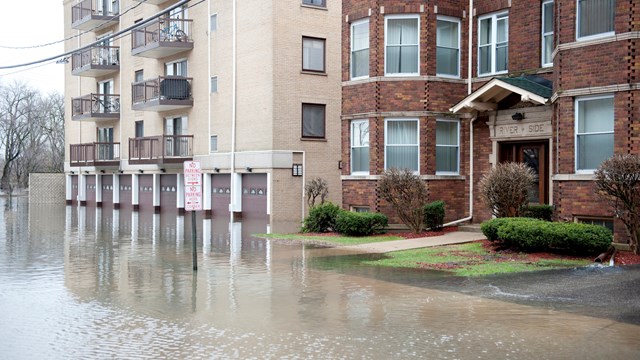Of all the modern conveniences we take for granted, perhaps none is as profoundly basic—and indispensable—as indoor plumbing. Carrying fresh water into our homes and taking waste water away, the pipes in our buildings are the fine line that separates us from our not-too-distant (also very aromatic, and very unsanitary) urban past. When plumbing fails, it doesn't take long to realize just how much we depend on it.
According to an essay on “Water and Urban Life” from the Encyclopedia of Chicago (http://www.encyclopedia. chicagohistory.org/), water began pumping into Chicago homes from municipal systems in the 1850s—less than 200 years ago. As water and sewer access expanded, so did costs; by 1885, Chicago residents had spent $2.5 million on indoor plumbing. While at first indoor plumbing was a luxury reserved for the wealthy, modern plumbing fixtures became affordable to the working class in the early 20th century. By 1930, any housing sans indoor plumbing was identified as substandard by the federal government.
Pipe Dreams
Although copper piping is the current norm, and is currently the predominant material used for water piping in new installations, many older buildings are still equipped with galvanized piping. “The issues with galvanized are two-fold,” says David Wiley, general manager with Nu Flow Midwest of Crystal Lake. “They deteriorate at the fittings where the protective coating has been removed as a part of the thread-cutting operation, and they have a proclivity to rust shut over time. The second issue is the root cause of most of the inquiries that we field: the home/unit owner will view this rusted condition as a loss of pressure that potentially results in a long wait-time for hot water. As buildings age, the diameter issue caused by galvanized pipes will tend to affect the hot water side of the domestic water system first.”
Hugh Hodur, owner of VanDerBosch Plumbing in Edgewater, concurs. “Most of the issues in high-rises and other buildings that are older – and we're talking 50-100 years—is with galvanized piping that's really nearing the end of its useful life, inspiring a lot of hot/cold water riser replacements.”
The Daily Grind
Indoor plumbing has come a long way from the days of carrying buckets of well water, but bringing water to the residents of a multifamily building is much different compared to a single family home, and comes with its own set of challenges.
“Customers most frequently complain about water pressure issues,” says Hodur. “Low water pressure on the hot or cold side of the the shower, or in the bathroom or kitchen sink.”
And issues vary depending on the nature of the property, according to Wiley. “The challenge of water delivery in the downtown, mid-to-high-rise market is vertical distance. Water loses pressure as it travels upward, so it must be pumped, or driven along its trajectory.” Booster pumps can help propel water, but, as Wiley warns, their presence and the resultant high pressure they discharge, “create myriad other challenges in respect to balancing water pressures and flows within a building.”
Not every issue in a high-rise or other multifamily property is purely a result of poor piping. “If a building is experiencing pressure/flow issues, there are some initial diagnostic steps that should be taken, including verifying the booster pump sizing and operation, and checking and cleaning the pressure reducing valves,” says Wiley. “Dirty and/or broken pressure reducing valves are a problem that we encounter quite frequently. Additionally, the hot water return system should be blown out if possible and the function of the hot water re-circulating pumps verified. Only once these mechanical issues have been cleared is it time to take a look at the piping itself.”
It's All About Maintenance
While there are a slew of legitimate plumbing problems that can inconvenience a property and its residents, there are routines and maintenance measures that should be adhered to that can help avoid stoppages or blocks down the road.
For example, Hodur has some quick and easy remedies for avoiding water pressure issues. “Remove your shower heads. Make sure they're clean. Same thing with the kitchen sink: remove the aerator on the faucet. Check both regularly for sediment and obstructions.”
And Wiley cautions about a more fungal pest. “Whenever water damage is detected, there's a rush to remediate the damage of a leak, during which the presence of mold can be overlooked. It is important to verify that no growth has begun before walls, floors, or ceilings are replaced and covered up.”
Despite there being a wealth of products on the market that tout an amazing ability to penetrate even the toughest stoppages, Wiley warns the consumer to be wary. “Let me stress this, as this is important: there are no chemical additives that will prevent or clear the stoppages in domestic water piping. The readers need to be cautioned against falling for any such promotions. Stoppages and blockages are mineral deposits accumulating, over time, on the pipe wall or interior diameter of the galvanized piping. Once started, they will continue unabated until pipe-lining or riser replacement are undertaken.”
Won't You Be My Neighbor?
In a multi-family building, one's plumbing woes are by no means their own. Anything that goes wrong in a single unit can have ramifications throughout the entire property, making it doubly important to be vigilant with your plumbing maintenance.
“We see a bit of 'kitchen stack lines,' which service multiple floors,” Hodur explains. Basically, this means that the plumbing for several stories' worth of kitchen appliances is vertically routed, so that, if someone has an issue on a higher floor, it can affect everyone from there on down. “What happens is, without proper and regular routing of the pipes, all of a sudden the guy on the first floor has water backing up in the sink, and the people above have no idea what's going on. At that point, you have to shut the water down, or have everyone stop using their kitchen sinks until they can be renovated, or routed out and cleaned.”
Yet another issue that can be avoided via tentative maintenance, but will prove disastrous should it fester.
Sloughing Through the Sewers
Plumbing doesn't begin and end with the pipes; everything comes back to the sewer at the end, and sewer systems require proper maintenance as well. While many of the techniques and tools mentioned above have steadily evolved over time, it's in the trenches where the real high-tech equipment is being deployed.
“We have programs with our customers where we're going out and doing annual video camera inspections of the sewers. If we're going out to a building for the first time, we'll propose a major mainline sewer cleaning—maybe hydro-jetting, which uses a high-pressure washer to clean the pipeline – and then a video inspection that will map out the entire system,” explains Hodur. “Then, we'll maintain these digital records for our customers, so that, should we identify an area that may prove problematic down the line, we'll put it on a watch list. Once or twice per year, depending on the situation, we'll come out, perform another video inspection, and, should we see any major change—like a significant pipe-shifting—we can recommend a more intensive repair.”
Hodur and Wiley both point out a correlation between sewer issues and kitchen waste systems, or “grease lines,” as they're often referred to in downtown buildings. As Wiley explains, “properties often clean only the horizontal drain piping that they can access—often in the parking garage/lower floor areas. Many times we've had to clean up after overflows that have occurred on the upper floors. These upper-floor-blockages and resulting overflows are often assumed to be caused by 'something put into the lines through a disposal or a sink.' The reality is that the vertical grease stacks in a building require maintenance just as the horizontal runs do.”
In-House Experts
On many occasions, building supers and handymen prove adept at handling small issues throughout the properties they serve. But they must be aware that, should a project of a significant magnitude emerge, they stand to do more harm than good should they not call in a professional.
“The capabilities of supers to handle plumbing issues are best judged on a case by case basis, and it's difficult to generalize,” says Wiley. “I'd counsel that, when dealing with either water supply or drain issues, it's best to call a professional. Remember that, what a super is encountering for the first time, we've encountered many times previously. The area where we often see the best of intentions yielding unsatisfactory conclusions is drain cleaning; there's really more of a science and methodology to this than people realize, and so often the effort that results in a temporary clearing creates issues that will be problematic down the line.”
Hodur notices a drop-off in supers tackling projects on their own, and attributes it to the age of many buildings in Chicago, and the complexity of the issues therein. “There's a trend away from building superintendents doing too much. I see them focusing more on tracking and maintaining. I'd say that half will call right away when they spot a problem, and half will attempt a fix on their own and call if they fail. But it used to be more of a 70/30 breakdown.”
The $10,000 Flush
The work of a plumber might seem straight-forward—fix a leak or unstop a clog—but depending what’s behind the cause of the leak or the stoppage, plumbers might have some interesting stories to tell, as Hodur can attest.
“We had a case where, after 'being a little bit over-served,' at a local watering hole, a woman came home, used her toilet, improperly flushed it and passed out on her bed. The toilet proceeded to overflow, going down about 15 floors. Someone discovered it and knocked on her door at five in the morning. She claimed that there must be something wrong with the pipes. We were called in by an insurance company just to do a video inspection, and we found out that there was absolutely nothing wrong with the pipes—and we are talking about hundreds of thousands of dollars in damages here.”
As with any system, the key to good plumbing is maintenance and repair. Take care of the system before something happens. This will avoid unnecessary grief later on, especially when residents are complaining.
Mike Odenthal is a staff writer with The Chicagoland Cooperator. Freelance writer Lisa Iannucci also contributed to this article.







2 Comments
Leave a Comment